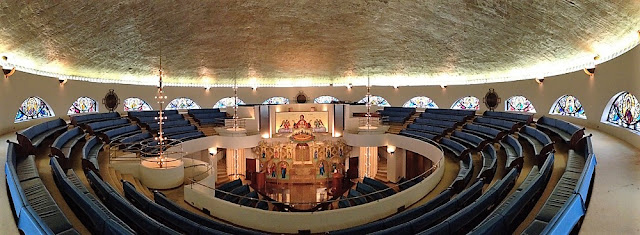 We had the good fortune to visit two churches in Wisconsin that were designed by Frank Lloyd Wright. Wright was born in 1867 (yeah, that surprised me too) in Richland, Wisconsin, a small town about 60 miles northwest of Madison. For a mid-westerner, he really got around. He designed over 1,000 structures, 532 of which were actually built. There are 25 structures designed by him in my home state of California, including the famous Hollyhock House. Wright lived a very colorful and often controversial life and died in 1959. In 1991 he was deemed "the greatest American architect of all time" by the American Institute of Architects.
We had the good fortune to visit two churches in Wisconsin that were designed by Frank Lloyd Wright. Wright was born in 1867 (yeah, that surprised me too) in Richland, Wisconsin, a small town about 60 miles northwest of Madison. For a mid-westerner, he really got around. He designed over 1,000 structures, 532 of which were actually built. There are 25 structures designed by him in my home state of California, including the famous Hollyhock House. Wright lived a very colorful and often controversial life and died in 1959. In 1991 he was deemed "the greatest American architect of all time" by the American Institute of Architects.
We visited the Annunciation Greek Orthodox Church in Milwaukee. Wright was 89 years old when he designed this church in 1956 (two years after the above photo of him was taken and three years before he died), and the church was completed in 1961, two years after his death. He drew from Byzantine architectural styles (particularly the Hagia Sophia in Istanbul) for his design. I love the reflecting pond out front that presents a shimmering, ephemeral version of the church:
We were so disappointed that it was locked up tight with no one around. Photos of the inside show it to be quite a spectacular church:
 |
| Picture from here. Go to the site for other gorgeous photos. |
I would have loved to see this window from the inside:




























